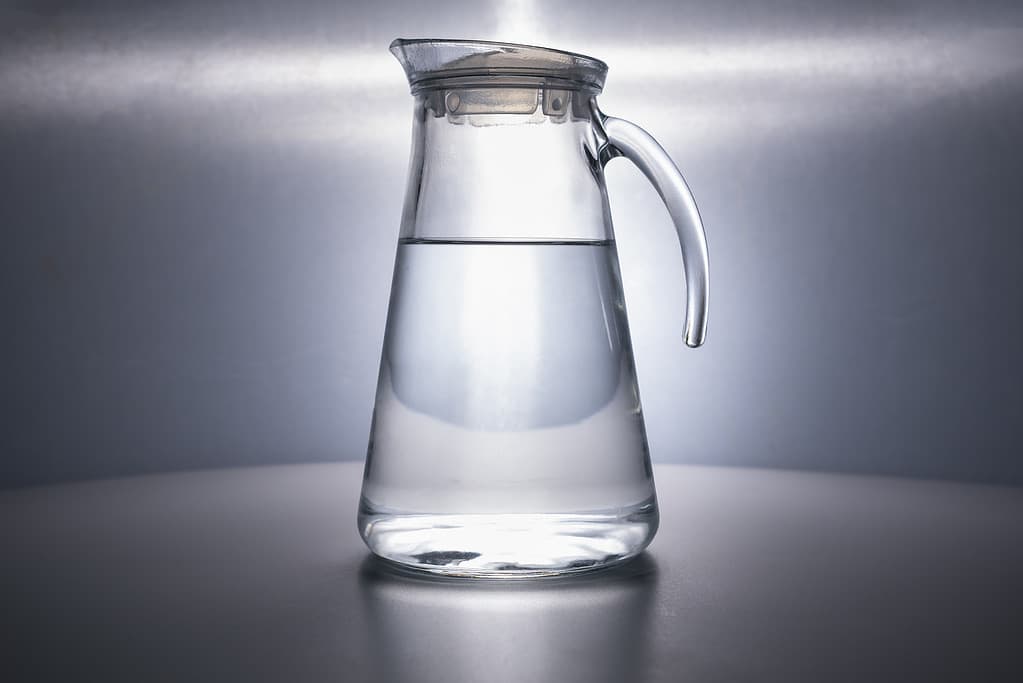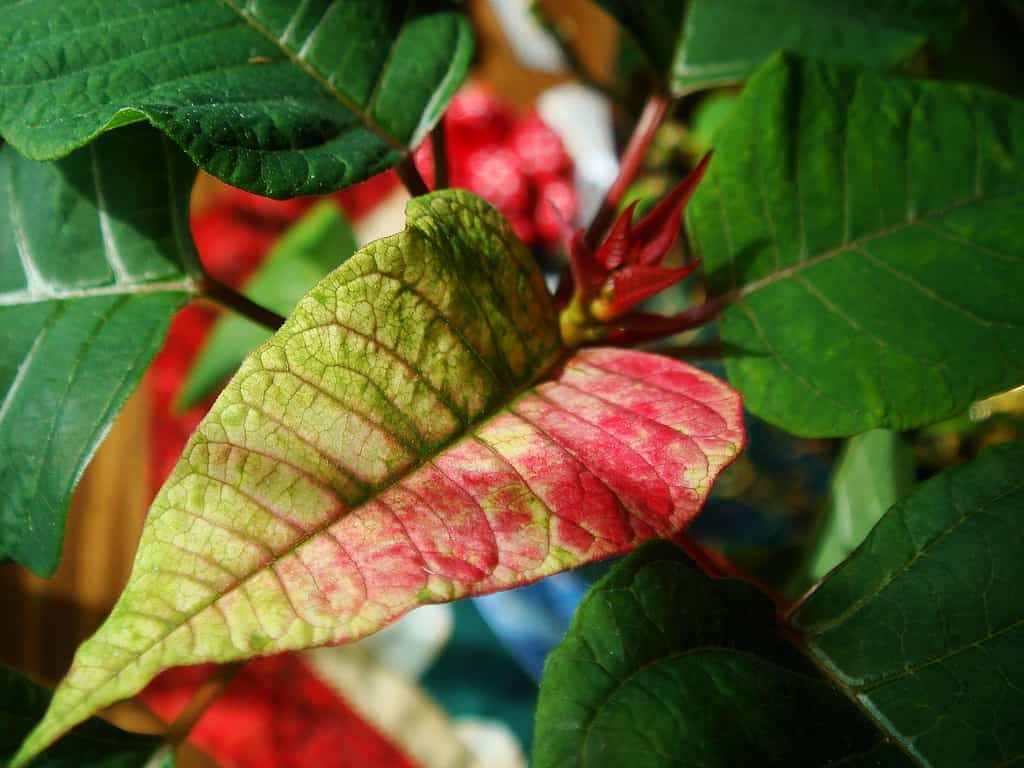Poinsettia plants are a sure sign of the holiday season’s arrival. In much of North America, there are attention-grabbing displays in garden departments or the front of supermarkets with a stadium-bleacher-sized group of them. And they can be a wonderful, richly colorful ornament for the home year-round if they are properly cared for. Follow these tips and there will be blooming bracts (interestingly, the “flower” part is the collection of golden nubs in the center) for Christmas in July. First question: how often do you water a poinsettia?
1 It’s Tricky Advice, but Water Them When They’re Thirsty

can be beautiful year round, but these are a high-maintenance houseplant.
©PinkCoffee Studio/Shutterstock.com
The answer to how often to water them is that it depends. Like most of the care tips for this genuinely gorgeous flower, effectively watering a poinsettia requires direct inspection of the plant itself and its current condition.
2 Choose a Healthy Plant and Avoid the Cold
First things first: choosing a healthy plant is essential. Look for leaves that are a healthy, deep green but not too dark. The bracts should be supple and have a rich color. Gently probe around the top of the soil to ensure it has a strong but not dry stem.
The poinsettia plant is quite sensitive to temperature. If purchasing a poinsettia during holiday errands, make it the last stop. Even a few minutes in a car below 55 F can be damaging. These are best ways to start off right in how to care for a poinsettia year round.
3 General Practices for Watering a Poinsettia
First things first: ensure the poinsettia plant has proper drainage. Watering a poinsettia plant varies from season to season, but ensure that the soil or growing medium can drain. A good step is to cut some drainage holes in the decorative foil or, better yet, trim off the bottom of the foil altogether to prevent any mold from developing.
Room temperature water is recommended.
4 Look for the Perfect Moment to Water Each Time

Look for the perfect time to water a poinsettia: when the soil beneath is still visibly wet, but the tip-top layer is dry.
©Irina Tkachuk/iStock via Getty Images
As indicated, check the soil daily to ensure it’s damp just below the surface. The perfect time for watering a poinsettia is when the very top is dry, but the wet darker soil beneath is still visible. Let it drink until it starts to drain. Keep a tray beneath it and empty any runoff immediately.
It can be taken outside but needs a certain type of spot (see temperature). In spring and summer, allow the soil to dry down to about 1.5 inches (3.8 cm) before watering. As with holiday season care, keep it in a location apart from any stiff winds (hot or cold) that can dry it out.
Poinsettias must return inside in the late summer and early autumn bloom. During that bloom, water slightly less than during the summer.
5 Temperature and Lighting, Go for a Greenhouse-Like Spot at First
For homes in the northern latitudes, be careful to keep poinsettias indoors but away from heat vents. The optimal heat is around standard room temperature of 68 F (20 C). Keep it above 60 F and below 70 F (15-23 C). 55 F is acceptable post holidays. Ensure there are no cold drafts either. Poinsettias can go outside for spring and summer when evening temps consistently stay above 50 F (10 C) and frosts have ceased.
Bring in before any frost sets in or the temperature drops below 50 F. Then keep at holiday temp.
The poinsettia thrives best with indirect sunlight. In the afternoon, full sunlight can be too much for them, so a south-facing window is ideal. How to care for a poinsettia year round can be tricky, but it’s worth it.
6 They Can Go Outside If There Is a Perfect Spot
If placing the poinsettia outside, ensure it is in a semi-enclosed space with afternoon shade to keep it from drying out. Keep the seasonal temperature in mind too. How often do you water a poinsettia? Not too much. Even if the rain is doing it, keep an eye on the soil.
7 Repotting and Watering a Poinsettia
Repotting the plant is best in late spring. Get a flowerpot three or so inches larger than the original. Keep up with temperature, light and watering best practices. Begin adding fertilizer in the summer. A weekly mixing of balanced fertilizer is recommended. The University of Hawaii College of Tropical Agriculture recommends a 15-15-15 mix (don’t worry, a skilled nursery manager will know what it means).
8 Ideas for Conveniently Providing that Blackout Environment
It is also a photoperiod plant, meaning it requires a specific blend of light and dark to bloom each year. Photos of greenhouses show enormous black curtains to give the poinsettias a blackout environment at night. How often do you water a poinsettia during the late summer, early autumn bloom? A little less than during the holidays; but only a little.
There are some options for home care to give the poinsettia some shut-eye. Try wrapping the plant in a garbage bag or placing it in a blackout dark closet. Ensure the bare minimum of 11 hours of complete darkness. Try a closed cardboard box if putting it in a frequently-used closet. Some gardeners say 14 hours of darkness is needed, but a good, easy rule to follow is 8 am to 8 pm (or thereabouts, depending on your schedule).
9 Keeping Them Healthy at First Goes a Long Way

The poinsettia bract blooming and coming into full color.
When purchased straight from a nursery, the plant will likely be in good health with good soil. Follow best practices for temperature, light and watering. Keeping them good and healthy through the holidays sets things on an excellent path.
An Ornamental Plant
Poinsettias (Euphorbia pulcherrima) come from South and Central America. Because US climates vary, keeping a vibrantly-colored specimen during and past the holiday season means they’ll have a delicate disposition. Like the fragile ornaments that trim the Christmas tree, poinsettias are delicious to the eye but require attention and care to ensure they stay intact.
The photo featured at the top of this post is © ZoomTravels/Shutterstock.com
Thank you for reading! Have some feedback for us? Contact the AZ Animals editorial team.







